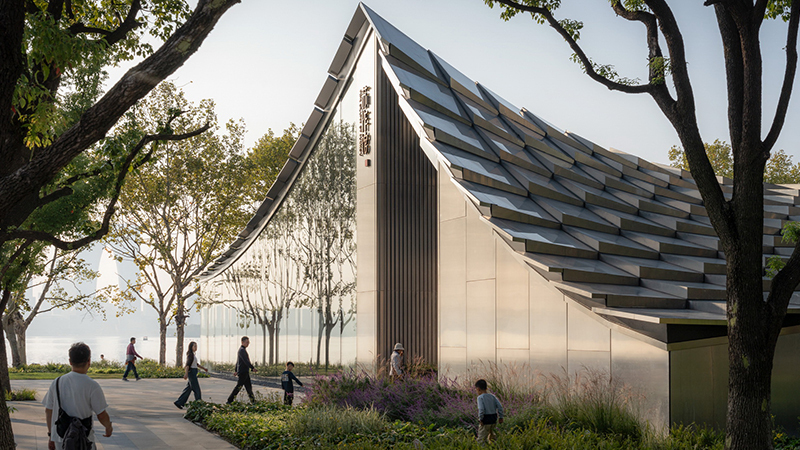| 公司: | Neutelings Riedijk Architects | 类型: | 建筑 |
|---|---|---|---|
| 地区: | 荷兰 | 标签: | 文化空间 |
Naturalis 是国家生物多样性研究所,其历史可追溯至 1820 年,由威廉一世国王在荷兰莱顿创立。拥有悠久历史的研究所在过去十年中经历了指数级的增长,游客人数迅速增加至每年 40 万人次,因此迫切需要进行翻新。以未來性(future-proof)设计的新 Naturalis 能容纳仍持续增加的 4200 万件物品(世界前五名)。其最先进的新设施可支援 200 多名备受关注的研究人员,他们的研究为气候变化、地球生物多样性下降、食品供应和水质等全球问题提供解决方案。 Naturalis 的设施和收藏能够提供最高水平的解决方案。同时,新博物馆提供了向公众展示自然的财富和美丽的机会。
Naturalis is the national research institute for biodiversity dating from 1820 which was founded by King Willem I in Leiden, The Netherlands. The institute with a long and rich history experienced an exponential growth in the last decade which led to an urgent necessity to renovate. The number of visitors increased rapidly to 400.000 per year. The new future proof Naturalis brings the growing collection of 42 million objects together (top five in the world). Its new state of the art facilities accommodate more than two hundred researchers whose studies are at the center of attention, contributing solutions to global issues including climate change, the decline of biodiversity on earth, food supply and water quality. The Naturalis facilities and the collection enable to contribute solutions at the highest level. At the same time the new museum offers the chance to show the public the wealth and beauty of nature.
该研究所的新设计以永续的方式整合现有建筑和新建建筑的可持续整体,每项活动都以特定形式进行。中庭连接了研究所的各个部分:现有的办公室和仓库与新建的博物馆和实验室。中庭的设计由一个呈椭圆形、三角形和六边形花边相互交织的三维混凝土结构组成。过滤后的光线通过圆形窗户作为“玻璃皇冠”进入,科学家、教职员工、学生和家庭在那里相遇,加强了空间的纪念性。
The institute’s new design forms a sustainable ensemble of existing buildings and new-build, with each activity housed in a specific form. The central atrium connects the various parts of the institute: the existing offices and depots with the newly built museum and laboratories. The design of the atrium consists of a three-dimensional concrete structure in the form of interlocking molecules as a lace of ovals, triangles and hexagons. The filtered light that enters through the circular windows as a ‘glass crown’ where scientists, staff, students and families meet, reinforcing the monumentality of the space.
餐厅、商店和展览厅等公共功能位于一楼,路人可以在那里看到最后被冲上岸的鲸鱼调查的检查。通往展览的主楼梯类似于一条山路,顶部变窄,有足够的空间迎接 Trix – 一只具有六千六百万年历史,在Dino Era 展厅中引以为傲的霸王龙。
Public functions such as the restaurant, the shop and the exhibition hall can be found on the ground floor where passers-by can catch sight of the examinations of the last whales washed ashore. The main staircase leading up to exhibitions resembles a mountain path, becoming narrower at the top with enough space to welcome Trix, the sixty-six million years old T-Rex which has been given pride of place in the Dino Era gallery.
展厅外立面以石块横层砌筑,模仿地质构造。其所使用的各种石灰华石材在漫长的岁月中形成了天然水晶,创造出美丽的光芒。由著名的荷兰时装设计师 Iris van Herpen 设计的白色混凝土元素饰带打断了石块层。受 Neutelings Riedijk Architects 的邀请,她设计了总共 263 块面板,灵感来自该系列的自然形状,由于为 Naturalis 开发的特殊技术,这些面板看起来像丝绸一样光滑。这种与面料的相似之处是对 Van Herpen 为 Cate Blanchett、Beyoncé 和 Lady Gaga 等名人设计的创新连衣裙的致敬。
The exterior of exhibition halls with stone blocks in horizontal layers mimicks a geological structure. Its travertine variety of stone used has developed natural crystals over the span of eons, creating a beautiful sparkle. The layers of stones are interrupted by friezes of white, concrete elements designed by a famous Dutch fashion designer Iris van Herpen. Invited by Neutelings Riedijk Architects, she designed a total of 263 panels, inspired by the natural shapes of the collection which seem to be smooth as silk, thanks to a special technique developed for Naturalis. Such a resemblance to fabric is a nod to the innovative dresses designed by Van Herpen for celebrities like Cate Blanchett, Beyoncé and Lady Gaga.
 |  |
Inside the museum, Dutch designer Tord Boontje known for his lighting, furniture and fabrics with exquisite floral and animal motifs, shows almost 100 striking and colorful wall panels. They are visual stories that blend photography and drawing to reveal the wonders of the natural world.
 |  |
The project covers a total of around 38,000 m2 of which 18,000 m2 of renovation and 20,000 m2 of new construction.
Project: Naturalis Biodiversity Center, Leiden, The Netherlands
Programme : museum 17.000 sqm, offices en depots 18.000 sqm, laboratories 3.000 sqm
Surface area: total of 38.000 sqm of which 20.000 sqm new built and 18.000 sqm renovation of existing buildings
Location: Darwinweg 2, Leiden, the Netherlands
Client: Naturalis Biodiversity Center
Start design: march 2013
Start construction: jan 2017
Completion: may 2019
In use: august 2019
Architectural design: Neutelings Riedijk Architecten
Architectural design team : Michiel Riedijk, Willem Jan Neutelings, Frank Beelen, Kenny Tang, Guillem Colomer Fontanet, Jolien Van Bever, Inés Escauriaza Otazua, Marie Brabcová, Cynthia Deckers
Architectural engineering: ABT BV Ingenieursbureau
Structural engineering: Aronsohn Raadgevende Ingenieurs
Installation design: Huisman en van Muijen
Building physics: DGMR Raadgevende Ingenieurs
General contractor: J.P. van Eesteren
Installations contractor: IC ULC-Kuijpers
Interior designer: Neutelings Riedijk Architecten
Designers of artworks: Iris van Herpen (betonreliëf), Studio Tord Boontje (grafiek)
Urbanist: Studio Hartzema
Cost calculation: IGG Bouweconomie
Landscape architect: H+N+S, Amersfoort
Photography: Scagliola Brakkee Fotografie
更新日期:2021-06-23 12:21:18
非常感谢 Neutelings Riedijk Architects 带来的精彩项目, 查阅更多Appreciations towards Neutelings Riedijk Architects for sharing wonderful work on hhlloo. Click to see more works!




















